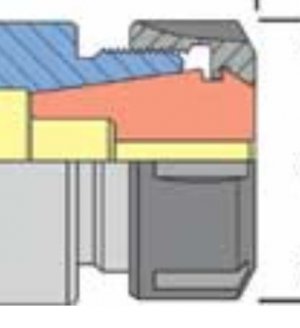The first thing you need to do is drill a hole "A" diameter by "E" deep. It's just a clearance hole so the diameter isn't critical.
Next comes the tapered bore. The taper you want to cut has a 16º included angle. Since you are only cutting on one side, you need to set your compound at one half the included angle or 8º relative to the center line of the spindle. The angle is critical because you want it to match the taper of your collets. It the taper is off, the collets may rock and cause whatever they are holding to wobble. There are ways to set the compound dead on to 8º, but for this first taper, just take a cut on the bore and check it to one of your collets. Get some Prussian blue from an auto parts store or an industrial supply, lightly blue the collet and give it a twist in your bored hole. The blue will transfer to the sides of the bore and tell you whether the taper of the bore matches the taper of the collet. Just keep adjusting the compound and taking trial cuts until the entire bore is blue, then you'll know your taper is right on.
I doubt the depth of the tapered bore is all that critical, but if you wanted to make it exact and know a little trig, you can drop a ball in the bore and calculate how far in it goes based on the diameter. Balls and rolls are how tapered bores or angled surfaces are measured.
It looks like an interesting part to make. Have fun with it.
Tom
 )
)

